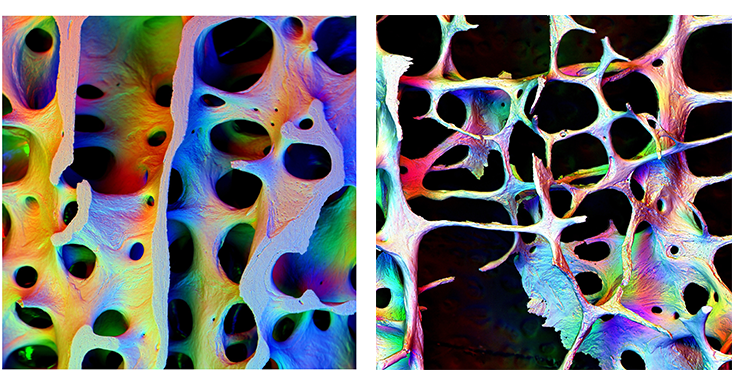Simplicity, simplicity, simplicity!” Henry David Thoreau exhorted in his 1854 memoir Walden, in which he extolled the virtues of a “Spartan-like” life. Saint Thomas Aquinas preached that simplicity brings one closer to God. Isaac Newton believed it leads to truth. The process of simplification, we’re told, can illuminate beauty, strip away needless clutter and stress, and help us focus on what really matters.
It can also be a sign of aging. Youthful health and vigor depend, in many ways, on complexity. Bones get strength from elaborate scaffolds of connective tissue. Mental acuity arises from interconnected webs of neurons. Even seemingly simple bodily functions like heartbeat rely on interacting networks of metabolic controls, signaling pathways, genetic switches, and circadian rhythms. As our bodies age, these anatomic structures and physiologic processes lose complexity, making them less resilient and ultimately leading to frailty and disease.

To understand this loss, we must first define what we mean by “complexity” in the scientific sense. Consider a Rube Goldberg machine, in which one action leads to another, then another, and so on in linear fashion to finally, say, scratch one’s back or bring a napkin to one’s mouth. Although this over-engineered contraption may look complicated, it’s actually quite simple: A given input always produces the same output. Its simplicity makes its behavior easy to predict. It also makes the system vulnerable because a single break in the chain will undermine its entire function.
A complex process, in contrast, involves multiple different components interacting across multiple scales in time and space. Because these interactions are nonlinear, outputs are not proportional to inputs and thus are more erratic and unpredictable. For instance, think of what it takes just to lift your foot. Electrical, chemical, and mechanical parts must continually coordinate across molecular, cellular, organ, and systemic levels. Genetic machinery inside cells generate proteins to power muscles; gastrointestinal organs digest and metabolize sugars to provide energy; motor centers in the brain plan and command movement, while nerves relay these messages to muscle fibers and deliver feedback to the brain about your foot’s location in space. As a whole, the process is something more than the sum of its parts.
The fractal-like networks of tissue in our brains, bones, kidneys, and skin all lose structural complexity as we age.
We can quantify the complexity of biological systems by borrowing mathematical ideas from chaos theory and the fields of nonlinear dynamics and statistical physics. One of these is the concept of fractals. A fractal is an irregular geometric object whose shape obeys an underlying pattern: It appears similar to itself on multiple measurement scales. Clouds, coastlines, trees, rivers, mountain ranges, and fault lines are all examples of fractal-like structures. Whether examined from an airplane or on the ground, with a magnifying glass or a microscope, their appearance stays generally the same.
Inside the body, arteries, neurons, bones, and bronchi are organized in a similar way. And if we measure across time rather than space, we also see fractal patterns in the moment-to-moment fluctuations in physiologic signals, including heart and breathing rates, blood pressure, brain waves, and hormonal secretions. Contrary to what you might expect, these fluctuations don’t follow regular, or periodic, patterns, but instead show a complex type of variability—what’s known as “deterministic chaos.” Although the oscillations are irregular, they appear self-similar when observed over seconds, minutes, hours, or days.

One way to measure the complexity of a fractal-like structure is to compute its “fractal dimension.” Fractals exhibit a property called “power-law scaling”: The smaller the measuring scale, the larger an object’s length. The fractal dimension, derived from this inverse relationship, tells us how much space the object fills. More space equals more complexity. A relatively bushy (more complex) branching structure such as a tree, for example, would have a higher fractal dimension than a leaner (less complex) one.
Another common metric of complexity, known as “multiscale entropy,” typically applies to processes, such as the beat-to-beat variability of your heart rate or the moment-to-moment postural shifts your body makes when balancing in a standing position. Multiscale entropy calculates the likelihood that a measured pattern repeats over various scales of time. Patterns with very low likelihood of repetition, such as white noise or randomness, aren’t very complex. Neither are patterns with high likelihood of repetition over a single time scale, such as the sinusoidal tick of a metronome. Patterns likely to have similarities across many different time scales, however, are more fractal-like, and hence more complex.
A large and growing body of research suggests that biological complexity diminishes with aging, as various tissues and organs, and their communication pathways, gradually break down. The fractal-like networks of tissue in our brains, bones, kidneys, and skin all lose structural complexity as we age. This loss impairs their capacity to adapt to stress, and may eventually lead to disease or disability. For example, when the microscopic struts in bone tissue thin and disconnect, as occurs with osteoporosis, bones become brittle and prone to fracturing. Likewise, the pruning of neural connections in the brain is associated with age-related neurodegenerative disorders, such as Alzheimer’s and Parkinson’s diseases.
Physiologic processes, too, lose complexity with aging. Take, for instance, heart rate. Although average beats per minute may stay relatively constant over a person’s life span, tiny variations in the timing between beats become more regular (less complex) with advancing age. Numerous studies have linked this change to cardiac disease and mortality: The simpler the signal, the higher the likelihood of abnormal rhythms, heart attacks, and heart failure. Similarly, neural activity produces electrical signals that appear less complex in older adults. As complexity declines, so do motor control and cognitive functions, including gait, attention, and memory.

The good news is that we may be able to slow, or even reverse, some of the complexity loss that comes with getting old. Aerobic exercise and resistance training, for example, have been shown to increase heart rate complexity. The Chinese practice of tai chi, which combines physical movement, breathing techniques, and meditation, has a similar effect on postural control. When you stand still, you may notice your body swaying ever so slightly as your muscles make tiny adjustments to keep you balanced on your feet. We can record these fluctuations on a force plate, which allows us to calculate their complexity. Lower complexity correlates with poorer balance, a slower gait, and risk of falling. But tai chi seems to provide an antidote: In one recent study, my colleagues and I found that just 12 weeks of tai chi training can improve the complexity of postural sway in elderly adults, including those in their 90s. Subjects who completed the training regimen also increased their gait speed and so may be more likely to avoid falls.
We’ve also found that we can improve the complexity of postural control by applying very weak, random vibrations to the soles of the feet. How this intervention works isn’t clear. It’s possible that the vibrations, which can’t be felt, add low-level noise to the sensory system, increasing input to nerve receptors, and thereby lowering their stimulation threshold. This phenomenon, known as stochastic resonance, may boost nerve cells’ ability to gather and react to information about the location and position of the feet. As a result, the body is able to make more complex, and hence more adaptive, postural adjustments.
There are additional benefits to be gained from maintaining complexity on the social scale. Studies consistently show that having an extensive and diverse social network is linked to better health and wellbeing. Compared to the socially isolated, connected individuals live longer, are less depressed, and are more likely to recover from heart attacks, strokes, and other acute illnesses. Simply adding complexity to your daily routine can have far-reaching effects: Learning new skills or solving mental puzzles, for instance, can help improve cognitive function and may help stave off dementia.
So if you dream of retiring to a quiet beach or to the woods, like Thoreau, “to live deliberately, to front only the essential facts of life,” I invite you to embrace a new mantra: Complexity, complexity, complexity!
Lewis A. Lipsitz is the director of the Institute for Aging Research at Hebrew SeniorLife, a professor of medicine at Harvard Medical School, and chief of the Division of Gerontology at Beth Israel Deaconess Medical Center, where he is a practicing geriatrician. His research focuses on the causes and prevention of impairments in mobility and cognition associated with aging.
The lead photocollage was created with images from Donald Iain Smith / Getty Image and David Vintiner / Getty Images






























